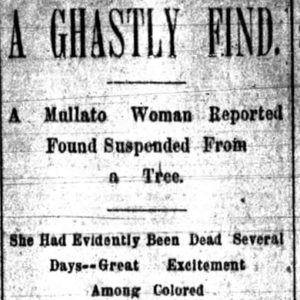calsfoundation@cals.org
Pulaski County Lynching of 1894
On March 11, 1894, a group of African Americans discovered the body of a “mulatto” woman hanging from a tree about halfway between Little Rock (Pulaski County) and Marche (Pulaski County). The woman was never identified but was estimated at thirty years old. The body, according to reports, appeared to have been there for several days (the Arkansas Gazette even described the corpse as “decayed”). Around her neck was a placard reading, “If any body cuts this body down, they will share the same fate.”
As the Arkansas Gazette reported, “The woman is supposed to have been lynched, but when, by whom and for what reason no one is able to state.” Indeed, although this murder is typically counted among the tabulations of lynching for Arkansas, its inclusion complicates traditional definitions of lynching. After all, lynching is often defined as a collective deed, one perpetrated by a group of individuals, small or large. However, no information is known about the perpetrators, making it difficult to classify it as a case of collective violence. But lynching is also typically viewed by scholars as an act designed to terrorize a larger population, and this event certainly meets that criterion, given that the placard placed around the woman’s neck did constitute a warning to those who might take down the body.
For additional information:
“A Ghastly Find.” Arkansas Gazette, March 12, 1894, p. 1.
Lancaster, Guy. “Before John Carter: Lynching and Mob Violence in Pulaski County, 1882–1906.” In Bullets and Fire: Lynching and Authority in Arkansas, 1840–1950, edited by Guy Lancaster. Fayetteville: University of Arkansas Press, 2018.
“Suspended from the Limb of a Tree.” Salt Lake Herald, March 12, 1894, p. 1.
Staff of the CALS Encyclopedia of Arkansas
 Civil Rights and Social Change
Civil Rights and Social Change Post-Reconstruction through the Gilded Age, 1875 through 1900
Post-Reconstruction through the Gilded Age, 1875 through 1900 Pulaski County Lynching Article
Pulaski County Lynching Article 




Comments
No comments on this entry yet.